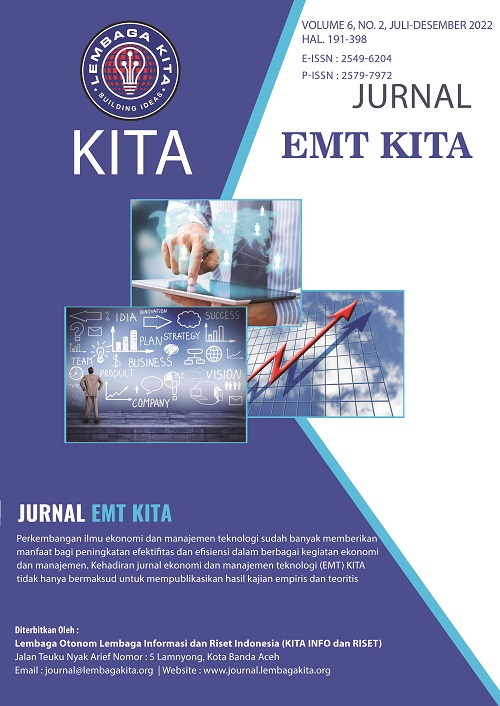Prediksi Tingkat Pengangguran Berdasarkan Data Time Series Menggunakan Regresi Linear (Studi Kasus : Kota Salatiga)
Main Article Content
Abstract
Unemployment is a very big problem. Coupled with the outbreak of the COVID-19 virus which resulted in many employees and workers being laid off. The purpose of this study is to predict the unemployment rate based on the number of the workforce. To produce an accurate prediction requires valid data in the long term. This makes it a reference for forecasting the unemployment population in a 5-year time series. For forecasting, a method is needed, namely the Linear Regression method. Linear regression is a statistical method that serves to test how far the relationship between the causal variables and the effect variables is. After forecasting, prediction data is generated in 2022, and the population and unemployment have changed from the previous year. Where the population in 2022 is predicted to be 144189 and the number of unemployed is 4513 people. This result is a prediction, not 100% accurate, therefore it would be better if you use another method to compare the prediction results and the level of accuracy.
Downloads
Article Details

This work is licensed under a Creative Commons Attribution-NonCommercial-NoDerivatives 4.0 International License.
An author  who publishes in the  Jurnal Manajemen Teknologi agrees to the following terms:
- Author retains the  copyright and grants the journal the right of first publication of  the work simultaneously licensed under the Creative Commons Attribution License that allows others to share the work with an acknowledgement of the work's authorship and initial publication in this journal.
- Author is  able to enter into separate, additional contractual arrangements for the non-exclusive distribution of the journal's published version of the work (e.g., post it to an institutional repository or publish it in a book)with the  acknowledgement of its initial publication in this journal.
- Author is  permitted and encouraged to post his/her  work online (e.g., in institutional repositories or on their website) prior to and during the submission process, as it can lead to productive exchanges, as well as earlier and greater citation of the published work (See The Effect of Open Access).
 Jurnal Ekonomi Manajemen Teknologi (EMT) KITA by http://journal.lembagakita.org/index.php/emt/index is licensed under a Creative Commons Attribution-ShareAlike 4.0 International License.
Jurnal Ekonomi Manajemen Teknologi (EMT) KITA by http://journal.lembagakita.org/index.php/emt/index is licensed under a Creative Commons Attribution-ShareAlike 4.0 International License.
References
Al’afi, A. M., Widiarti, W., Kurniasari, D., & Usman, M. (2020). Peramalan Data Time Series Seasonal Menggunakan Metode Analisis Spektral. Jurnal Siger Matematika, 1(1), 10-15.
Ashari, M. L., & Sadikin, M. (2020). Prediksi Data Transaksi Penjualan Time Series Menggunakan Regresi Lstm. Jurnal Nasional Pendidikan Teknik Informatika: JANAPATI, 9(1), 1-10.
C. Nurine S. K (2018). “Analisis Pengaruh Indeks Pembangunan Manusia, Tingkat Pengangguran, Pertumbuhan Ekonomi, dan Upah Minimum Provinsi Terhadap Tingkat Kemiskinan (Studi Kasus pada 6 Provinsi di Pulau Jawa)”, Fakultas Ekonomi dan Bisnis. Universitas Brawijaya.
F. S. Nur Ravika. (2016). “Pengaruh Variabel Ekonomi Makro Terhadap Pengangguran Terdidik Jawa Timur Tahun 2010-2014. Surabaya : PT.Bumi Universal Makmur”, Jurnal Ekonomi Pembangunan Vol.14, No.01 Juni 2016.
Fadlillah, Nurul. (2016). “Analisis Pengaruh Pendapatan Per Kapita, Tingkat Pengangguran, IPM dan Pertumbuhan Penduduk Terhadap Kemiskinan di Jawa Tengah Tahun 2009-2013”, Fakultas Ekonomi dan Bisnis, Universitas Jenderal Soedirman. EKO-REGIONAL, VOL.11, No.1.
I. H. Andrian. “Penerapan Metode Fuzzy Time Series Untuk Prediksi Penjualan Berbasis WEB pada CV.AGVA Kota Pasuruan”. Teknik Informatika, ITN Malang, Malang.
Ikhlas, M., & Adipradana, W. (2020). Peramalan Beban Pada Tahun 2019-2023 Menggunakan Metode Time Series Pada Penyulang Dieng Di Gardu Induk Simpang Tiga Indralaya (Doctoral dissertation, Sriwijaya University).
Katemba, P., & Djoh, R. K. (2017). Prediksi Tingkat Produksi Kopi Menggunakan Regresi Linear. Jurnal ilmiah FLASH, 3(1), 42-51.
N. Shofiatin. (2018). “Pengaruh Jumlah Penduduk dan Jumlah Pengangguran Terhadap Jumlah Penduduk Miskin di Provinsi Banten”, Fakultas Ekonomi dan Bisnis Islam. Universitas Islam Negeri Sultasn Maulana Hasanuddin Banten.
Nidyashofa, Nurika. (2020). “Pemilihan Model Regresi Spasial Terbaik Pada Tingkat Pengangguran Terbuka Di Provinsi Jawa Tengah”. Program Studi S1 Statistika. Fakultas Matematika Dan Ilmu Pengetahuan Alam. Universitas Muhammadiyah Semarang. Semarang.
Oktavianti, I., Ermatita, E., & Rini, D. P. (2019). Analisis Pola Prediksi Data Time Series menggunakan Support Vector Regression, Multilayer Perceptron, dan Regresi Linear Sederhana. Jurnal RESTI (Rekayasa Sistem dan Teknologi Informasi), 3(2), 282-287.
P. Ratih. (2016). “Pengangguran dan Pengaruhnya terhadap Tingkat Kemiskinan. Balai Besar Penelitian dan Pengembangan Pelayanan Kesejahteraan Sosial”, Jurnal PKS Vol 15 No 2 Juni 2016; 89-100.
R. A. Salbiah and W. Adi. (2016). “Faktor-faktor yang mempengarhui tingkat kemiskinan”, Fakultas Ekonomi dan Bisnis, Universitas Mulawarman, Samarinda. JIEM – Volume 1(1), 2016.
Rahakbauw, dkk. (2018). “Sistem Prediksi Tingkat Pengangguran Di Provinsi Maluku Menggunakan ANFIS (Adaptive Neuro Fuzzy Inference System)”. Jurusan Matematika FMIPA. Universitas Pattimura. Ambon.
S. Dwi (2018). “Penyebab Tingginya Angka Pengangguran Di Kota Metro”, Fakultas Ekonomi Dan Bisnis Islam. Institut Agama Islam Negeri Metro.
Sandy, dkk. (2019). “Analisa Pengaruh Pendapatan Asli Daerah dan Dana Desa Dalam Menurunkan Tingkat Kemiskinan Di 11 Kabupaten Provinsi Sulawesi Utara”. Jurusan Ekonomi Pembangunan, Fakultas Ekonomi dan Bisnis. Universitas Sam Ratulangi. Manado.
Sumardin, A., & Mashud, M. (2018). Penerapan Metode Time Series Dalam Memprediksi Hasil Produksi Pertanian Berdasarkan Nilai Trend. Inspiration: Jurnal Teknologi Informasi dan Komunikasi, 8(1), 25-30.
Wahyuni, S. C. (2021). Peramalan Jumlah Penduduk Miskin Di Pulau Jawa Menggunakan Metode Fuzzy Time Series Chen (Doctoral dissertation, UNIVERSITAS MUHAMMADIYAH JEMBER).
Yunus, Erna. (2022). “Angka Kemiskinan Salatiga 2021 Naik 5,14%”. Angka Kemiskinan Salatiga 2021 Naik 5,14% - RMOL JATENG (rmoljawatengah.id). Diakses pada 30 April 2022.

